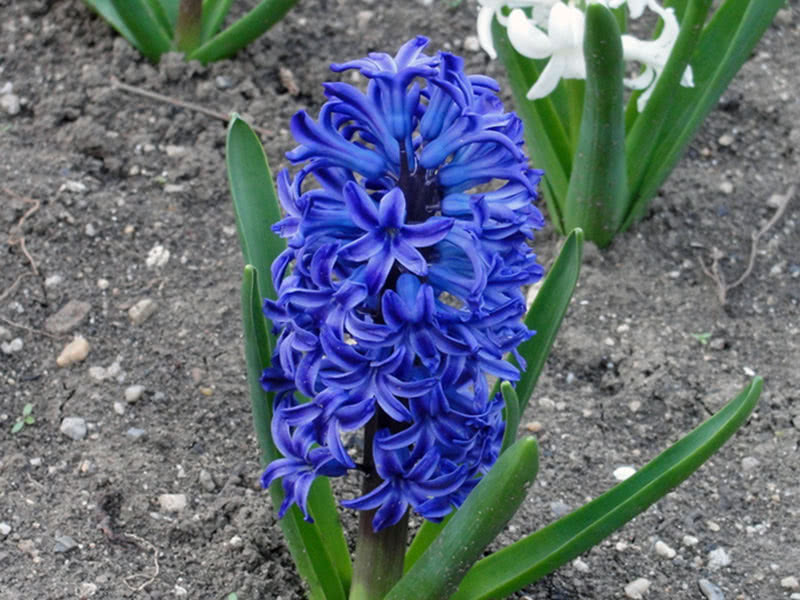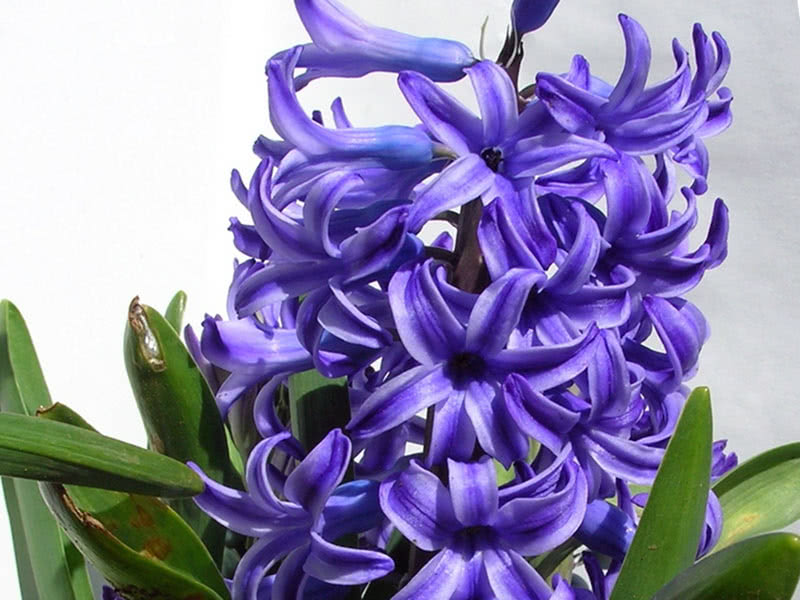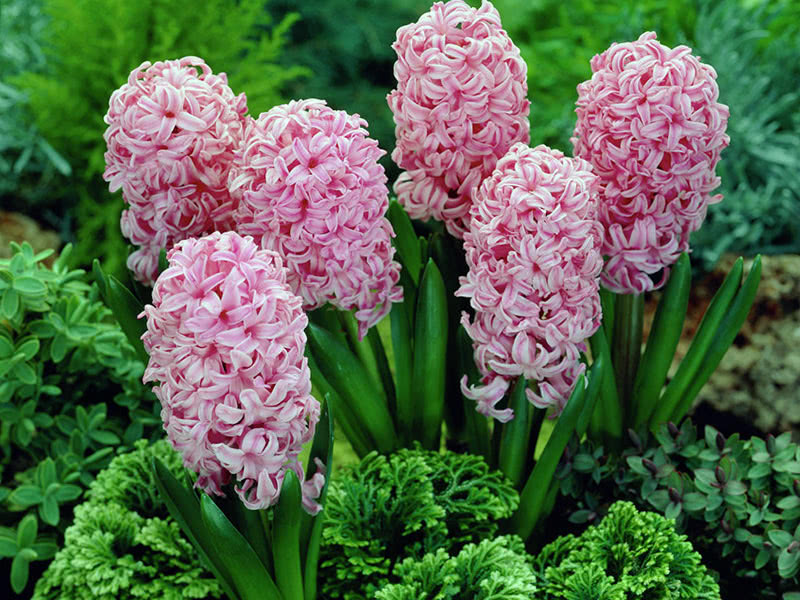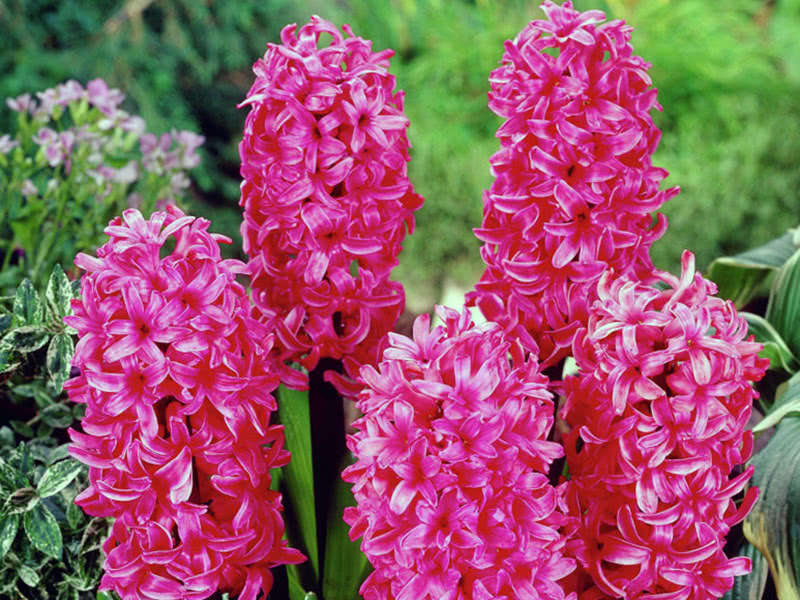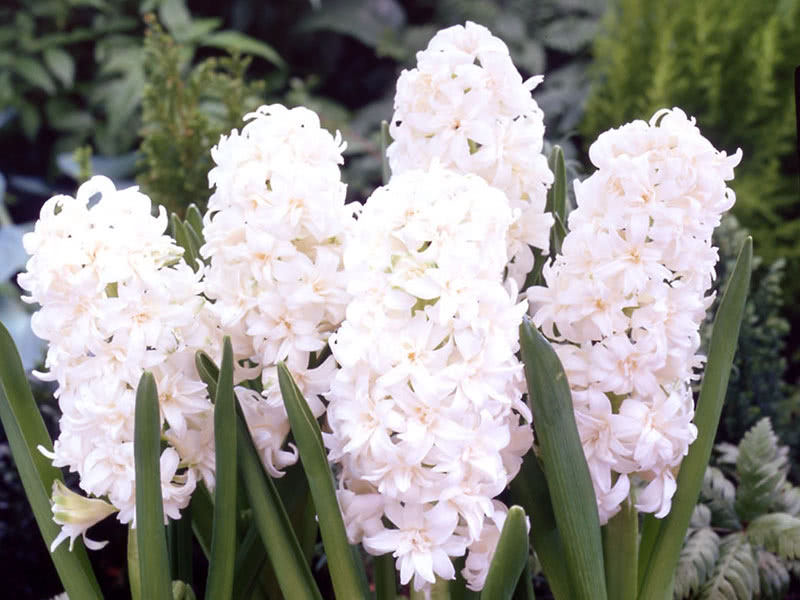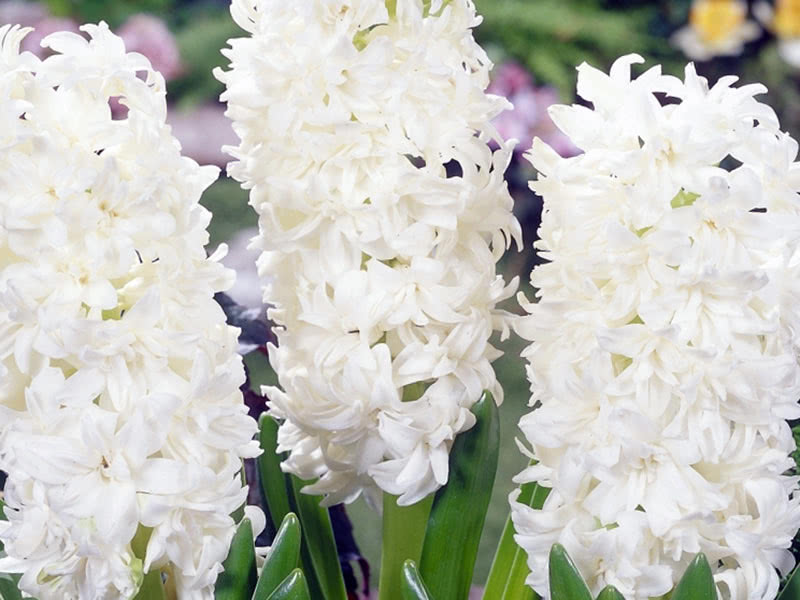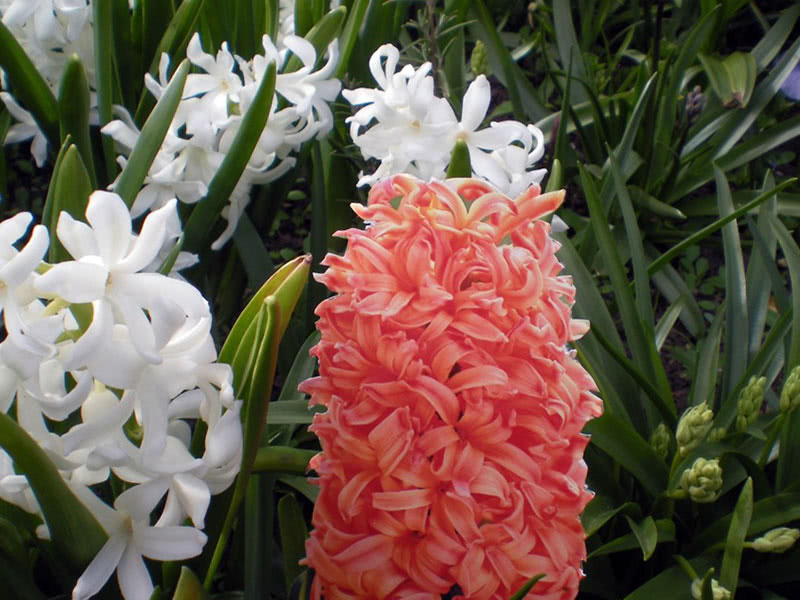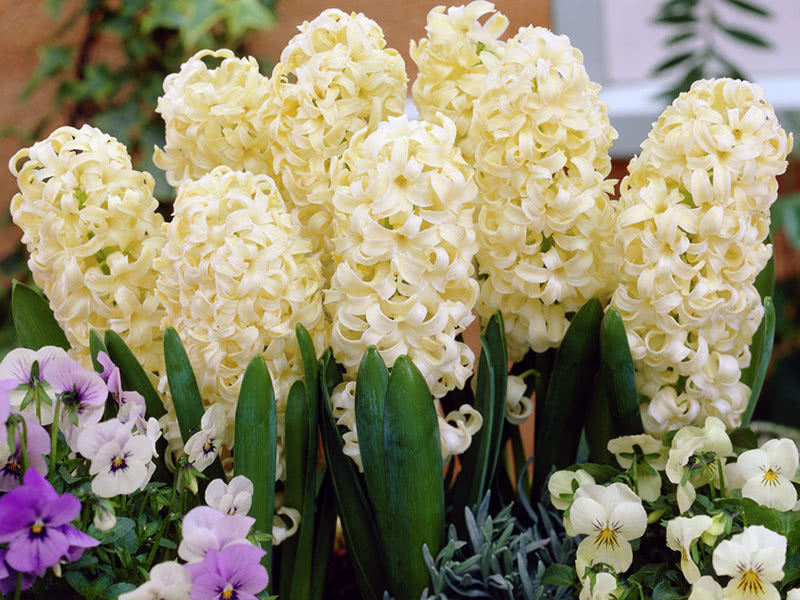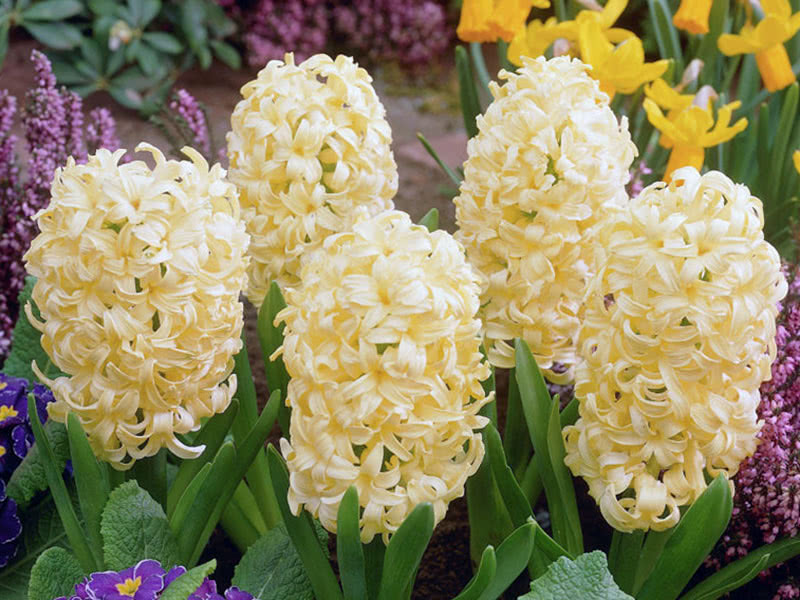Hyacinths – growing, planting, care after flowering
 Hyacinth (lat. Hyacinthus) is a genus of bulbous perennials in the family of Asparagaceae, although it used to belong to a separate family of Hyacinthaceae and was formerly classified in the lily family Liliaceae. The name of the flower is translated from the Greek language and means “flower of rains”. The flower was named after the hero of the ancient Greek myth: in those days there was a beautiful young man, Hyacinth, the son of King of Sparta, a young friend of the god Apollo who often descended from heaven and taught Hyacinth to throw a discus.
Hyacinth (lat. Hyacinthus) is a genus of bulbous perennials in the family of Asparagaceae, although it used to belong to a separate family of Hyacinthaceae and was formerly classified in the lily family Liliaceae. The name of the flower is translated from the Greek language and means “flower of rains”. The flower was named after the hero of the ancient Greek myth: in those days there was a beautiful young man, Hyacinth, the son of King of Sparta, a young friend of the god Apollo who often descended from heaven and taught Hyacinth to throw a discus.
During one of the training sessions, Apollo threw the discus, and Hyacinth rushed after to pick it up and bring to Apollo, but the god of the West wind, secretly in love with the prince, in a fit of jealousy turned the flying disk so that it broke the boy's head. Hyacinth was bleeding in the arms of his almighty friend who could not save him. Heartbroken and filled with tenderness, Apollo created a flower from the blood of Hyacinth and gave it the name of the deceased young boy …
Hyacinth flowers – description
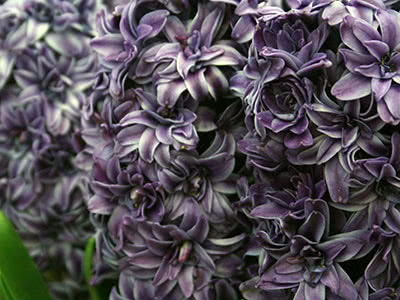 Hyacinths are one of the earliest spring flowers. The motherland of hyacinths is the Middle East, South Africa and the Mediterranean, but the Netherlands has done so much to popularize the flower, that it can be called the world's "hyacinth center". The largest number of species and varieties of hyacinths was created in the Netherlands, and every year millions of hyacinth bulbs are sent all over the world from the Dutch city of Haarlem. Thick bulbs of hyacinths consist of succulent lower leaves, the blossoming stem ( 12 inches in height) that is the continuation of the collum dries out after flowering along with narrow, upwardly directed leaves located on the stem at the very bottom, but in the corner of the top leaf, on the stem inside the bulb, a bud is formed that gradually turns into a bulb that will bloom in the next year. In the corners of other leaves weak bulbs, so-called babies, are also often formed and they can be separated and used for vegetative propagation. The flowers of the hyacinth are collected in the apical carpal inflorescences that have the shape of a cylinder or cone. The perianth of the flower is a bright bell-shaped funnel with bent lobes. The color of hyacinth can be any: white, red, pink, lilac, blue, pale yellow ... Hyacinths can be simple and double. The fruit of hyacinth consists of three capsules and in each section there are two seeds with a gentle peel.
Hyacinths are one of the earliest spring flowers. The motherland of hyacinths is the Middle East, South Africa and the Mediterranean, but the Netherlands has done so much to popularize the flower, that it can be called the world's "hyacinth center". The largest number of species and varieties of hyacinths was created in the Netherlands, and every year millions of hyacinth bulbs are sent all over the world from the Dutch city of Haarlem. Thick bulbs of hyacinths consist of succulent lower leaves, the blossoming stem ( 12 inches in height) that is the continuation of the collum dries out after flowering along with narrow, upwardly directed leaves located on the stem at the very bottom, but in the corner of the top leaf, on the stem inside the bulb, a bud is formed that gradually turns into a bulb that will bloom in the next year. In the corners of other leaves weak bulbs, so-called babies, are also often formed and they can be separated and used for vegetative propagation. The flowers of the hyacinth are collected in the apical carpal inflorescences that have the shape of a cylinder or cone. The perianth of the flower is a bright bell-shaped funnel with bent lobes. The color of hyacinth can be any: white, red, pink, lilac, blue, pale yellow ... Hyacinths can be simple and double. The fruit of hyacinth consists of three capsules and in each section there are two seeds with a gentle peel.
Species and varieties of hyacinths
Hyacinths have been grown in the garden and on the windowsills for about 400 years, and not so long time ago these flowers were represented by approximately 30 species and 500 varieties. But after the reorganization of classifications in botany, most of the species was classified to another genus. Now there are only three species of hyacinths: garden hyacinth (Hyacinthus orientalis), Hyacinthus litwinowii and Hyacinthus transcaspicus. These species serve as the basis for the cultivation of countless varieties and forms of plants. Varieties of hyacinths are classified by the shape of the flower (simple and double), terms of flowering (early, middle and late) and by the color of flowers. In the flower color classification there are six groups:
Blue hyacinths
- Perle Brillante is a late hyacinth of pale-blue color, its height is 10 inches, it blooms up to three weeks;
- Marie is an early variety with dark blue flowers and with a violet longitudinal strip. It blooms for 16-18 days;
- Queen of the Blues is a mid variety with light blue flowers and with a weak aroma. Its height is 12 inches. It flowers for two weeks;
Lilac hyacinths
- Blue Magic is a mid variety with purple-violet flowers. Its height is 10 inches and it blooms for 10-12 days;
- Indigo King is a late variety with black-violet shiny flowers. The height of flower stalk is 6-6.7 inches. It blooms for two weeks;
- Bismarck is an early variety with pale purple flowers and with a longitudinal strip of lighter color. Its height is 8.6-10 inches and it blooms for two weeks;
Pink hyacinths
- Moreno is an early variety with pink-raspberry flowers and a dark stripe. Its height is 7.8-9 inches and blooms for 13-18 days;
- Anna Marie is a mid variety with peduncle height of 7.8-10 inches, it blooms for 15-17 days with light pink flowers;
- Gertruda is a late variety with dark pink flowers. The height of peduncle is 9-10 inches, it blooms for 13-15 days;
Red hyacinths
- Hollyhock is a late double variety of red and crimson color. The height of peduncle is 7.8-8.6 inches, it blooms for 15-18 days;
- La Victoire is an early variety with shiny red and pink flowers. Its height is 7.8-19 inches and it blooms for 11-12 days;
- Tubcrgen's Scarlet is a mid variety of bright red color. Its height is 7.8-8.6 inches and it blooms for a little longer than two weeks;
White hyacinths
- Arentine Arendsen is an early variety of white, sometimes cream color. The flowering period lasts for 15-18 days, the height is 8.3-8.7 inches;
- Snow Crystal is a late variety with white double flowers. It blooms for 13-18 days, the stem height is 10-11 inches;
- Madame Sophie is a mid variety with white double flowers. The stem height is 7.5-9 inches. It blooms for 13-15 days;
Yellow and orange hyacinths
- Yellow Hammer is mid variety of bright yellow color that turns colorless by the end of flowering. The height is 9-10 inches, the flowering period is 13-15 days;
- City of Haarlem is a late variety, flowers are light yellow, by the end of flowering they turn light cream. The height of peduncle is 10-11 inches, it flowers for 15-17 days;
- Oranje Boven is a mid variety of salmon-apricot color and with dark pink edges. Its height is 8.6-9.4 inches. It blooms for two weeks.
As a rule, blues varieties are the first to bloom. Then they are followed by white, pink, red, lilac varieties. Yellow and orange varieties of hyacinths bloom later than all the others.
Peculiarities of hyacinth growing
Each plant has its own requirements. Hyacinth is a capricious plant, and a flower grower who decided to decorate the garden with these flowers must know how to care for hyacinths properly. The following features must be well known by a hyacinth fan::
- the soil substrate for hyacinths should be neutral and consist of equal parts of leaf and turf soil with the addition of baking powder. If the soil on the site is acidic, it needs liming. Sand must be added to the clay soil;
- a good drainage is very important, because hyacinth does not tolerate waterlogging;
- the lighting should be bright, but you should avoid a direct sunlight;
- the site must be protected from strong wind, so many growers prefer to plant hyacinths near shrubs and trees;
- do not use organic fertilizers for hyacinths.
Planting of hyacinths in the open ground
When to plant hyacinths
Planting of hyacinths in the ground is carried out in late September or early October. If planted earlier, hyacinths can quickly start growing and die during winter colds, and with a later planting hyacinths may not have enough time to take root before frost. Prepare the site for planting of hyacinths in advance: dig the soil to a depth of 12-16 inches, add mineral fertilizers (approximately 2.5 oz of superphosphate, 0.5 oz of magnesium sulfate, 1 oz of potassium sulfate per 11 ft²), three to four year old humus or a rotted compost at a rate of 22-33 pounds per 11 ft². If necessary (depending on the composition of the soil), also add sand or peat. If the soil is sandy, then you should increase the amount of magnesium and potassium fertilizers by one and a half times. It is better to apply nitrogen fertilizers in spring and summer.
Planting of hyacinths in autumn
As already mentioned, hyacinths should be planted in the open ground in September-October. Flower growers recommend planting of not very large bulbs, but medium ones, the so-called flower bed bulbs, that will produce peduncles that will be more resistant to bad weather. The bulbs are sorted, removing soft, sick and damaged ones. Before planting the bulbs, they are kept in a solution of the fungicide for half an hour.
The depth of planting of hyacinth bulbs from the collum should be 6-7 inches (for the bulbs about 2 inches in diameter), the distance between them should be 6 inches, and the distance between rows should be 8 inches. Smaller bulbs and babies are planted closer and not so deeply. Hyacinth grows well in the open ground, if they are placed in a “sandy shirt”: a layer of clean river sand 1.2-2 inches thick is placed on the bottom of the planting hole or furrow, the bulb is pressed slightly into it, covered with sand and then with soil. This way of planting prevents water stagnation in the soil, therefore, the risk of rotting of the bulb is decreased. After planting of the bulbs, if the soil is dry, water the site.
Planting of hyacinths in spring
In spring hyacinth is not planted.
Care for hyacinths outdoors
How to care for hyacinths in the garden
Care of hyacinths is not complicated, but the requirements must be followed strictly. Firstly, hyacinth likes cleanness, so weed control on a site with hyacinths is a must. In addition, the plant needs constant loosening of the soil. If you want to make your task easier, and at the same time to protect the soil from drying out and to control weeds and diseases, you need to mulch the soil after planting. As for irrigation, it is necessary during a drought period: a soil clod should get wet 6-8 inches deep.
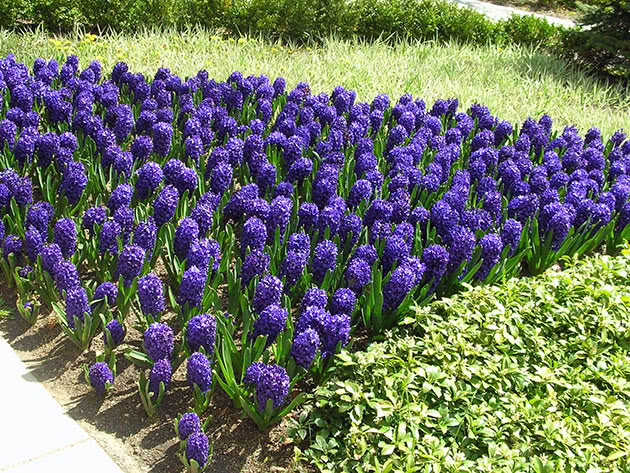
Feeding of hyacinths is carried out 2-3 times during the growing season. Fertilizers are applied both in a dried and liquid state, but if a liquid fertilizer is used, you should take less amount of a fertilizer and water the soil before its applying. Dry fertilizers are scattered over the soil and then are mixed with the soil by a hand trowel. For the first time, fertilizers are introduced at the very beginning of growth (0.5-0.7 oz of superphosphate and 0.7-0.9 oz of saltpeter per 11 ft²); for the second time you should apply them during the budding period (0.5-0.7 oz of potassium sulfate and 1-1.2 oz of superphosphate); for the third time fertilizer is used when hyacinths finish flowering (1-1.2 oz of superphosphate and potassium sulfate).
Hyacinth transplanting
It is easy to transplant hyacinths: in summer you should dig up hyacinth bulbs after flowering, store them until autumn, and in autumn transplant them to another place. When to dig up hyacinths? You can do this in 2 months after the end of hyacinth flowering, when the bulbs regain strength after this year vegetation.
Propagation of hyacinths
Propagation of hyacinths is done by bulb-babies and seeds. For those who are engaged in plant breeding, the seed method is more suitable than others: in autumn, at the end of September, the seeds are sown in boxes with the soil consisting of sand, leaf land and humus at a ratio of 1: 1: 2, and grown for two years in a cold greenhouse, but the seedlings almost never repeat the qualities of the parent plants, so amateur growers prefer the vegetative way of propagation. However, the growth of babies is slow: every year 1-3 babies appear. If they are easily separated from the mother bulb, they are planted in the soil and grown further, and if the babies do not separate, the mother bulb is planted along with the babies.

In industrial floriculture such artificial methods of propagation as cutting and incision of the collum are used: cuts are made on the collum with a sharp sterile tool or it is cut out at all so that when it is further stored in a special way, the bulb form new babies. Sometimes the result is staggering – up to forty babies on one bulb. If you are interested in these methods, you can learn more about them in the book “Propagation of plants” by F. McMillan Brouse.
Diseases and pests гиацинтов
Hyacinths do not suffer from most of plant diseases, but if unfortunately they get sick, here is the list of main reasons:
- the purchase of already contaminated planting material;
- too heavy acid soil;
- you used fresh organic fertilizer;
- adverse predecessors;
- missed a spoiled bulb when sorting;
- preventive disinfection of bulbs before planting was neglected;
- hyacinths were very densely planted.
Hyacinths are mainly affected by yellow bacterial rot (bacterial disease) that turns bulbs into foul-smelling slime. The first symptoms are lag in growth, spots and stripes on the peduncle and leaves. Affected plants should be dug out and burned, and a hole should be processed with bleach. The symptoms of penicillium rot (fungal disease) are coverage of all aboveground parts with plaque (the product of fungus spores) and their rotting, the flowers dry. The fungus is controlled by spraying with copper-containing drugs.

Hyacinths are attacked with root-eating flies the larvae of which eat up the collum of the bulb. You can destroy them with insecticides. Also, mole cricket as well as the root onion mite can be very harmful as they eat the underground organs of plants, and the best means of controlling them is mulching of the soil.
Sometimes you can face with the following problem: the inflorescence, not having time to appear from the rosette, falls out of it. The reason is not disease, but excess moisture in the soil, too early planting or storage at too low temperature.
Hyacinths after flowering
Гиацинты отцвели – что делать?
Care for hyacinths after flowering implies giving the bulbs an opportunity to restore their strength. To do this, they must be left in the soil for some time. How to care for fading hyacinths? All you need to do is to gradually reduce irrigation until its complete cessation. In addition, during this period mineral fertilizers should be applied for the third time. It is necessary to add nutrients to the bulbs for the next year flowering. Yellowed leaves will indicate you when it's time to dig up the hyacinths after flowering.
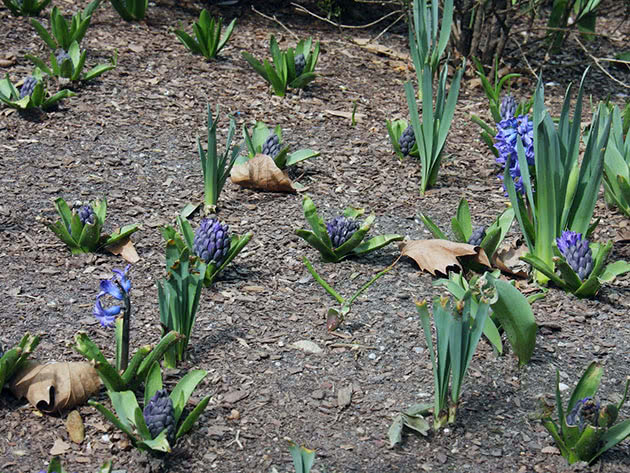
Digging up of hyacinths
Bulbs of hyacinths should be dug out annually, otherwise in the next year their flowering will be much poorer, in addition, it increases the risk of bulb disease. Annual digging also allows you to monitor the state of the bulbs and timely separation of the babies for further growing up. Do not wait for the leaves to die and fall off, because then it will be difficult to locate the bulb. Dig up the bulbs with a shovel since they are placed in the ground quite deeply, wash them in running water, process them with a three to four percent solution of carbophos for half an hour or keep them in a hot water at a temperature of 122°F for 10 minutes. Then they are aired and dried in a dark place at 68 °FC for a week.
Storage of hyacinth bulbs
The most important period is coming, because at this time an inflorescence is formed in the bulb. The dried bulbs are cleaned from the remains of roots and peels, sorted and placed in boxes, preferably in one layer. If a baby is small, it is better not to separate it from a mother plant. If there are not too many bulbs, they can be stored in paper bags by placing signed labels on them.

There are two stages of storage: for the first two months the bulbs are stored at a temperature of 77-79 ºF, and for the third month the temperature should be 63 ºF with not very low humidity, so that the bulbs do not dry out. It is possible to make the first stage last one week by setting a temperature of 86 ºF in the first seven days of storage. The room should be well ventilated. And before the autumn planting it would be great to keep the bulbs for a week at a temperature close to that in the garden. During storage, bulbs often form a lot of small babies, so be very careful when planting them in the ground in autumn.

